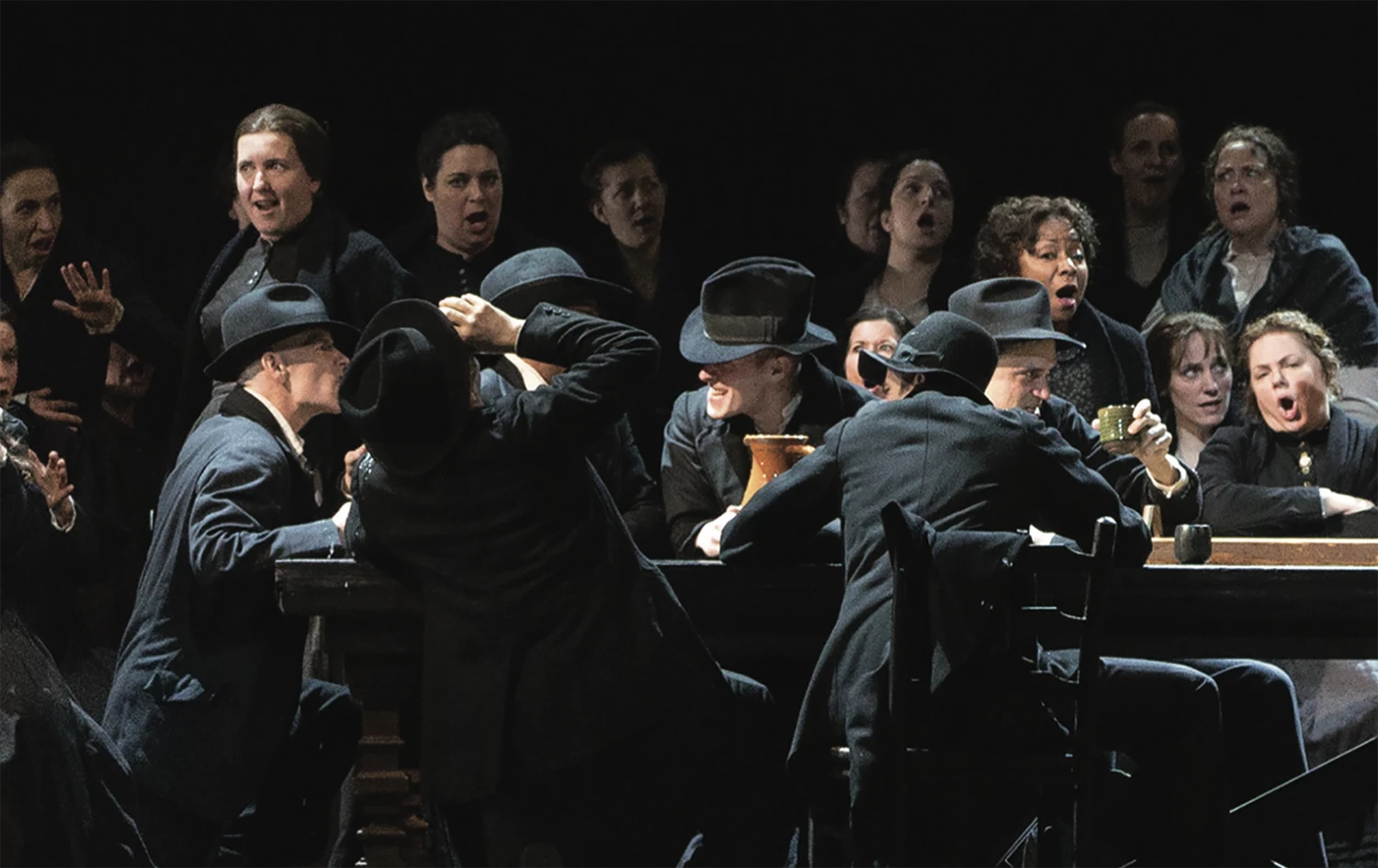When New York City’s Metropolitan Opera (The Met) began its initial production development for a new double-bill program of Mascagni’s Cavalleria Rusticana and Leoncavallo’s Pagliacci, its team of engineers and set designers were stumped on how they could bring together a rotating hydraulic design with the power and data needs the show would require.
One of the main keys to the performance was the use of the Met’s rear wagon turntable, which is essentially a motorized wagon used to preset scenery by driving it on and off stage and facilitate rapid transitions of very large-scale scenery, said Jeff Mace, Director of Production Operations for The Met.
The rear wagon turntable is behind the main stage when viewed from the audience, and it has a built-in 58-ft diameter rotating turntable, originally commissioned in 1966. Over the years, new capacities have been introduced to this turntable, such as a 208-V, 3-phase rated power transmission slip ring for high-voltage electric transmissions, and a single data commutator to pass Ethernet data through the slip ring. This allows the Opera to have the turntable spinning in front of the audience, but also to control equipment and effects, lighting, automation, video, and more.
The Production, directed by David McVicar with set design by Rae Smith, required a 30-person banquet table on that turntable. At the time, Mace said, the team was not sure if the table would be raised up and down more than once or if the lowering and raising was going to happen while rotating, so they needed a solution that could fit all those needs.
It became readily apparent a hydraulic solution was needed, because they needed the power density and lower noise afforded by hydraulic systems versus something actuated by electric motors. A standard hydraulic scissor lift seemed the most logical choice.
“And then we had to confront the problem of how to get hydraulic fluid power distribution out to the cylinders at the time of this effect, when we had no idea if we were going to need to do this while it was rotating, or while it was fixed,” Mace said. The rotation possibility introduced complexity because finding an off-the-shelf rotary union that could fit the bill was impossible.
Mace turned to his regular stage production experts but when they learned of another complex issue the design would require – the space required for the hydraulics and electromechanical components needed to fit a 12 in. envelope – they suggested Mace call Dan Turner of Turner Hydraulics/ TASCorp., of Carlisle, Pa.
So Mace contacted Turner, asking him for help with rotary fluid power all while maintaining the slip ring and data functions in a compact space.
Turner was intrigued by the custom need. He and his team surveyed the system. “And somehow, miraculously, Dan said, ‘No problem,’ and took it on board. Dan and his team worked collaboratively with our in-house engineers, kind of iteratively, sharing models and drawings back and forth, and talking about end user functionality and accessibility and basic ergonomics of using the system. One of the things that really impressed me in that interaction was Dan’s attention to detail with respect to the end user, with respect to this thing not just being schematically functional but utilitarian and useful and accommodating of the environment.”
Turner Hydraulics and its subsidiary TASCorp. (Turner Automation Services Corp.) designed an apparatus that is comprised of a fixed frame that is bolted to the base of the wagon with a rotating frame that’s connected to the rotating part of the wagon. Between those two frames is the hydraulic rotary union in a 10.5-in. form factor with four ports of hydraulic fluid transmission – a pressure line, tank line, drain or pilot operating line, and pressure line or second tank line.
The team at TASCorp. and Turner made the custom hub which transfers all the utilities up to the house using the AutoDesk CAD program Inventor. “What we had to do was come up with a way to allow the stage to rotate infinitely in any direction while full electricity, hydraulics and computer operations were operating whatever was on the set.”
So Turner’s team decided to have the Ethernet communications at the center, and were able to acquire an off-the-shelf commutator that would allow that to happen.
Mace said that the data slip ring is double the bandwidth of the Met’s previous solutions. “We went from having the capacity to transmit one data stream on one single network, and we would previously have had to decide, are we going to use the data transmission capability for the automation network or the video network or the lighting network? But Turner was able to facilitate two data connections, so we now have double the flexibility. And then in addition to the data, he packaged a power transmission slip ring that also doubled our amperage capacity. So we had a 280-V, 3-phase slip ring that was rated for around 200 A, and he increased in the same footprint to 400 A capacity. So in addition to getting the kind of hydraulic solution we were aiming at, we doubled our capacity on power and data as well, without making any material modifications in house. It was really remarkable.”
To manage this power level, Turner worked with an outside vendor to bend the power rails into a circle that could fulfill the 208 V need. This, said Turner, would allow the rails to always stay connected even as the stage turned. Junction boxes were included on the set and house side so they could feed power to the unit.
To accommodate the hydraulics, they designed a compact swivel unit with quick disconnects for all the lines plugged into the base of the unit all while feeding through the center of the unit. It allowed for four channels of 50 gpm or three channels of 50 gpm and a drain line.
“The beauty of it is that everything has disconnects, whether it’s the electrical or the hydraulics and the Ethernet, so they just pop cover plates off of the center of the stage. And they just plug in whatever it is, whatever utility they’re trying to use,” Turner said. “They don’t have to do any hard wiring or hard piping or anything like that. It’s all very convenient.”
Once the hub unit was complete, Turner’s team and the Met’s engineers had two weeks to install it and ensure it functioned properly. “Dan’s team came in, and we wheeled it into place, picked it up with a hoist, lowered it into place, and bolted it in. It wasn’t quite as painless as I just made it sound, but it was pretty close. So within two days after taking delivery, we had the primary apparatus installed and tested. Frankly, it couldn’t have gone more smoothly.”
In the end, the show only used one function of the hub Turner designed – “The table only raises and lowers in front of the audience, but the turntable is not rotating, so you can’t quite tell that there’s magic happening there from the audience’s perspective,” Mace said.
“But this has introduced a new creative capacity into the opera house. We do use this hydraulic distribution quite regularly to set up production effects and production elements that are hydraulically powered,” Mace continued. “So the thing I’m getting at, Dan is solving our problems. He’s not trying to fit us into the mold of any kind of pre- packaged solution. That iterative and tailored process and that willingness to find solutions to problems, is incredibly compatible with what a creative company like the Metropolitan Opera House needs to interact with. It’s flexible in all the ways that we need. We’re trying to pull off these incredible one-time feats. And Dan is well-suited to participate in that universe.
“When people come to me and they say, ‘I need a hydraulics guy,’ he’s the only person I recommend, because he’s got what it takes to keep up with our industry, which tends to be tight timeline, low budget, heavy lifts. And it’s not always easy to find reliable partners, and it’s certainly not easy to find them willing to keep coming back for more projects.”
FLUID POWER WORLD DECEMBER 2020
Published on Dec 15, 2020
https://issuu.com/wtwhmedia/docs/fpw_december_2020


Leave A Comment